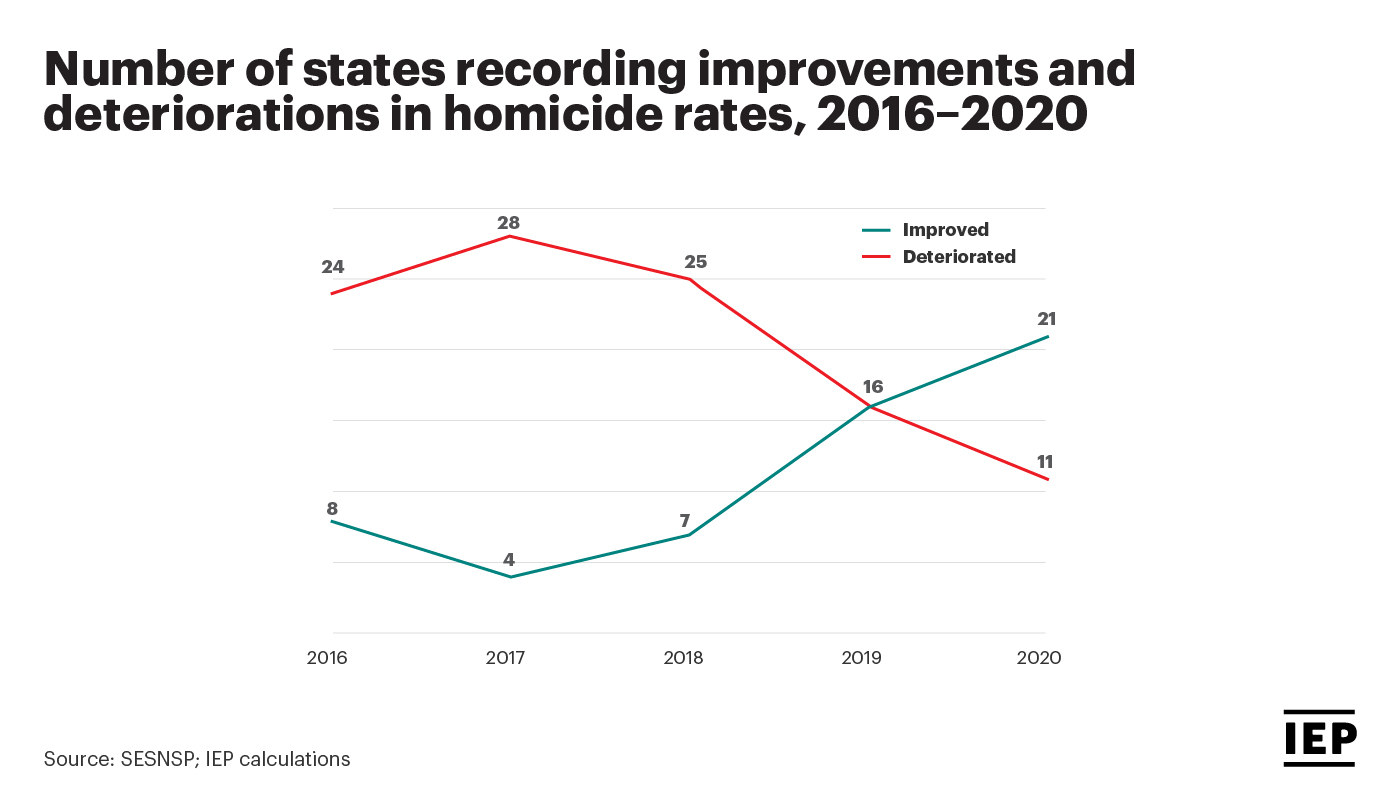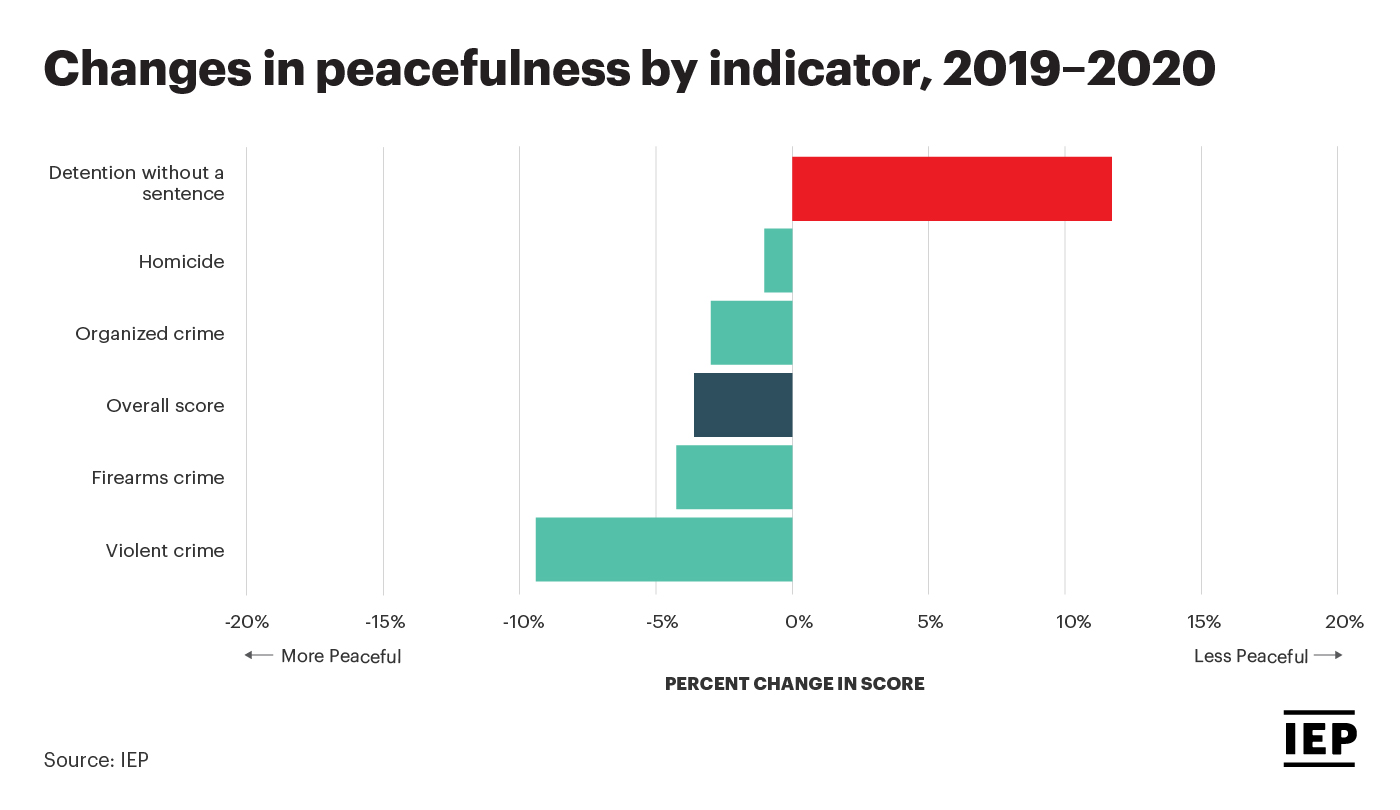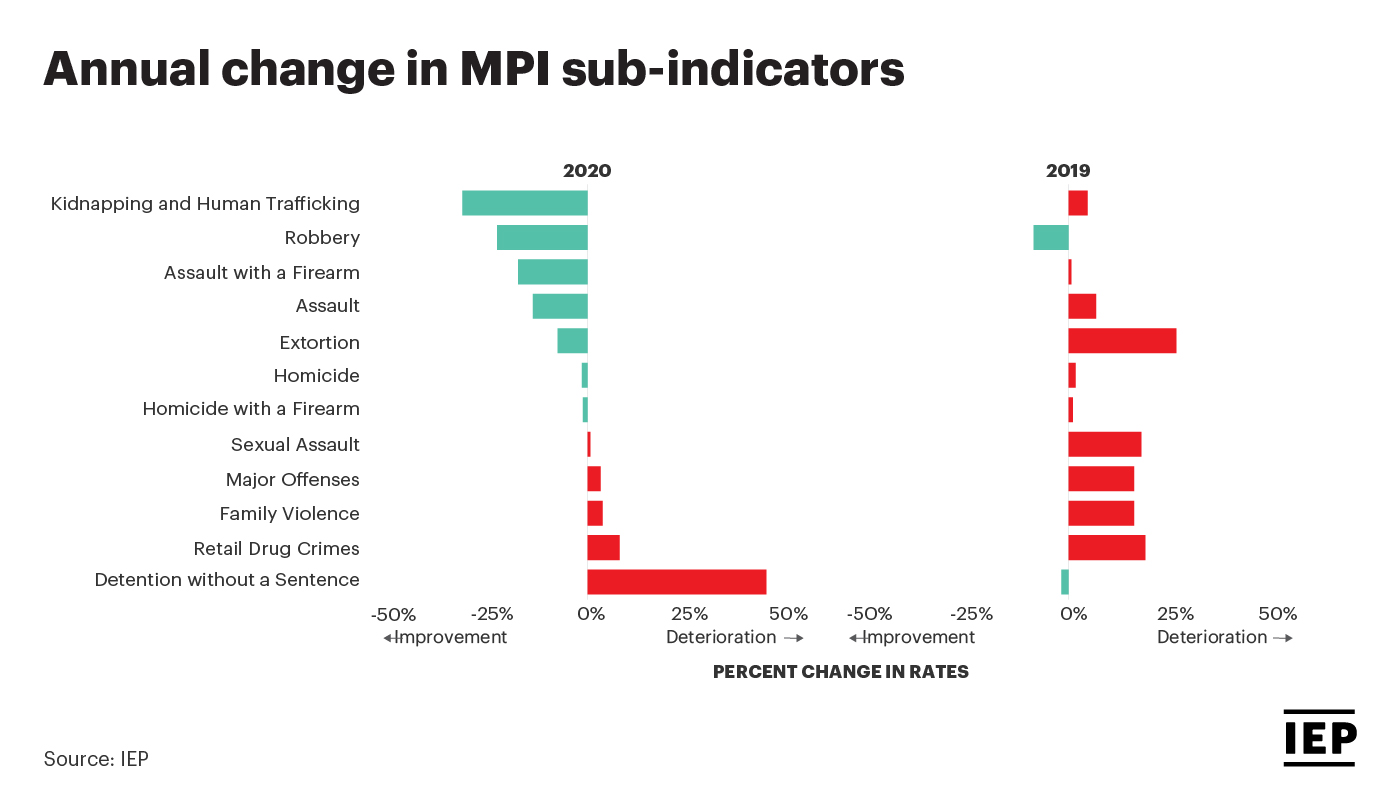Increase in peacefulness signals a new trend for the 2021 Mexico Peace Index. Most indicators have shown some improvement since July 2019, especially violent crime following the COVID lockdowns.
The economic impact of violence in Mexico was estimated at 4.71 trillion pesos in 2020, equivalent to 87,256 pesos (US$4,092) per Mexican worker.
The homicide rate improved by 1.3% in 2020. With over 35,000 deaths, Mexico has the ninth highest homicide rate in the world.
Twenty-two states recorded an overall improvement in 2020, while ten deteriorated. This is the first time in five years that more states have improved than deteriorated in peacefulness.
Yucatán is the most peaceful state in Mexico, with Baja California the least peaceful state.
The 8th edition of the annual Mexico Peace Index (MPI) report finds that Mexico’s peacefulness improved by 3.5% in 2020, with four of the five indicators improving.
This comes after four years of successive deterioration and marks a change in trend that began prior to the onset of COVID-19. From July 2018, homicide and firearms crime rates peaked and have since been gradually declining.
Other crime rates began to fall in mid-2019, also preceding the COVID-19 pandemic. Although still very high, this indicates that Mexico may be experiencing a change in trend in its levels of violence.

Twenty-two states recorded an overall improvement in 2020, while ten deteriorated.
Most peaceful states:
Yucatán was the most peaceful state in the country for the fourth consecutive year, followed by Tlaxcala, Campeche, Chiapas, and Nayarit.
Least peaceful states:
The five least peaceful states were Baja California, Colima, Zacatecas, Chihuahua, and Guanajuato.
This is the first time in five years that the majority of states have improved their levels of peacefulness.
Despite the improvement in 2020, levels of violence are historically high. Levels of homicide were up by 84.1% since 2015, while organised crime rose by 40.5%.
In 2020, more than 35,000 people were victims of homicide, or 27.8 deaths per 100,000 people. The largest deterioration since 2015 was retail drug crime, which increased by 125 percent.
Accompanying this, gun violence nearly doubled in the same period, with twice as many crimes being committed with a gun.
The total economic impact of violence to Mexico is more than double the total yearly exports from the automotive industry, Mexico’s largest industrial sector.
The costs associated with violence remain high, yet government expenditure on countering violence has decreased. Since 2015, expenditure on domestic security services has fallen by 31.4 percent.
Government spending on domestic security and the judicial system as a percentage of GDP is less than half of the Latin American average, at only 0.7% of total GDP.
This deficit limits the capacity of the judicial system to process cases, leading to high rates of impunity. However, military spending and private protection costs increased when compared to 2019, highlighting a shift towards using the military to combat organized crime.
Carlos Juarez, Mexico Program Director comments: “In addition to the personal suffering, violence comes at a heavy cost to our economy. In 2020, the economic impact of violence was seven times higher than public spending on healthcare.
Even a 10% reduction in violence would provide an additional 471 billion pesos’ stimulus to the Mexican economy. This level of stimulus is urgently needed to help recover from the pandemic.”

The only indicator to deteriorate in 2020 was ‘detention without a sentence’. This was the first time since 2015 that this indicator has deteriorated.
The number of detainees without a sentence increased substantially after March 2020, which appears to be related to the partial shutdown of criminal courts during the pandemic.
Mexico has the ninth highest homicide rate globally, and it is also home to the five cities with the highest homicide rates in the world: Tijuana, Ciudad Juarez, Uruapan, Irapuato, and Ciudad Obregon.
The border city of Tijuana registered a homicide rate of 134 deaths per 100,000 people in 2019, 20 times higher than the global average.
In 2020, there were distinct trends for male and female victims of homicide. Male homicides account for 87% of the total, and are more likely to be linked to organized crime.
Homicide was the main cause of death among men between the ages of 10 and 54. In contrast, female deaths are more likely to be associated with intimate partner violence. Femicides have increased at a similar rate to that of male homicides, increasing by 116% since 2015.
Along with the improvement in the homicide rate there was an accompanying improvement in the economic impact of homicide, which fell by 72.3 billion pesos or 3.1% compared to the previous year.

The violent crime rate improved in 2020, decreasing by 13.3% due to a drop in kidnappings, robbery and extortion.
Although the violent crime rate had begun to show signs of improvement prior to 2020, it fell significantly after March 2020, driven by the Government’s public health measures and stay-at-home recommendations due to the COVID-19 pandemic.
High levels of violence in Mexico were characterised by increased violence against the police, politicians, and journalists. In 2020, 524 police officers were killed, representing an increase of 17.5% over the previous year.
Political assassinations are also on the rise, with at least 139 politicians, government officials and candidates killed between September 2020 and March 2021. At least 8 journalists were killed in connection with their work in 2020, one of the highest numbers globally.
The organised crime rate has increased by 40.5% since 2015, “Building peace in Mexico and dealing with the high levels of violence require comprehensive and well-articulated strategies to tackle corruption and executed in a decisive manner. It also requires the strengthening of institutions, and a rebuilding of people’s trust in their governments,” said Carlos Juárez.
Between 2009 and 2019, levels of corruption and government efficiency in Mexico deteriorated significantly.
Research has found that these changes preceded increases in violent demonstrations, perceptions of crime, and homicide rates, which have all increased over the last decade.
This highlights the link between institutional effectiveness and violence. Mexico ranks 117th out of 163 countries in terms of controlling corruption according to the World Economic Forum, and has fallen 46 positions in the last ten years, indicating the urgency of addressing this shortcoming.